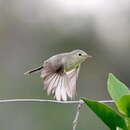Biology
provided by Arkive
This small, inconspicuous bird feeds primarily on insects and spends its days quietly foraging high in the dense forests, plucking its prey from the foliage, while habitually jerking its tail up and down (2) (5). Pairs of Rodrigues warblers appear to remain together in a territory throughout most of the year (2) (5).
During the breeding season, which extends from late September to March, pairs of Rodrigues warblers construct a nest. Usually this is a small cup structure, with a deep inside lined with a few feathers, that is situated up to nine metres off the ground, supported in the fork of slender branches. Two or three eggs are laid in each clutch, with possibly two broods being raised each breeding season. Both sexes share the responsibility of incubating their precious brood (2).
Conservation
provided by Arkive
The slow recovery of the Rodrigues warbler since 1969 has been the result of efforts to protect the island's watersheds, which allowed the surrounding forests to mature and recover, and a switch to the use of bottled gas for cooking, lessening the demand for firewood (5) (6). Nature has also played a role in this species' recovery, with a recent absence of catastrophic cyclones allowing populations to increase (6). While much of the reforestation has involved exotic trees, native species are being replanted in some areas, including two Conservation Management Areas, where grazing animals and woodcutters are kept out and exotic plants are removed (6). Exotic plant species are a major cause of the lack of native habitat on the island, but these introduced trees and shrubs also provide a vital haven for the Rodrigues warbler in the absence of native forest. For the native forest to regenerate, it is considered necessary to remove all exotic tree species, but this may have a short-term detrimental impact on warbler populations. Hopefully, the long-term benefit, to the island and to the Rodrigues warbler, will outweigh this short-term loss (5). To mitigate the potential catastrophic effects of another introduced predator, catastrophic cyclone or drought, the possibility of introducing the warblers to a small predator-free island has also been considered and feasibility studies have been undertaken (5).
Description
provided by Arkive
An unfortunate inhabitant of one of the world's most ecologically degraded tropical oceanic islands (4), the Rodrigues warbler is a small bird with a relatively long, mostly flesh-coloured bill, and a long, graduated tail (2). Olive-brown plumage covers the upperparts, while the underparts are pale lemon-yellow in fresh plumage, turning greyish with a slight wash of yellow as the plumage becomes more worn. Above the eye runs a yellowish line, like an eyebrow, and a dark stripe extends through the eye. The relatively long legs are grey (2). A fairly unobtrusive bird, the Rodrigues warbler is infrequently heard, but has a soft, melodic song and a harsh chattering alarm call (2) (5).
Habitat
provided by Arkive
Since human inhabitants destroyed nearly all native vegetation on Rodrigues Island, the Rodrigues warbler is now found in dense thickets and woodland dominated by introduced trees and shrubs, preferably close to clearings or the forest edge. The majority of the population is found in areas dominated by rose-apple (Syzygium jambos), but areas of mahogany (Swietenia mahogoni), tecoma (Tabebia pallida) and Norfolk Island pine (Araucaria cunninghami) are also inhabited (2) (5).
Range
provided by Arkive
The Rodrigues warbler occurs only on Rodrigues Island, the smallest of the Mascarene Islands, situated in the Indian Ocean, where it is restricted to just a few valleys in the centre of the island (2).
Status
provided by Arkive
Classified as Endangered (EN) on the IUCN Red List 2007 (1) and listed on Appendix III of CITES (3).
Threats
provided by Arkive
During the 1950s and 60s, the natural habitat of Rodrigues Island was extensively cleared for timber, firewood, and farming (5) (6), leaving it one of the most degraded tropical oceanic islands in the world (4), and significantly decreasing the warbler population (5). Then, in 1968, one of the most severe cyclones to ever have hit Rodrigues struck and, with a search in 1969 failing to find any warblers, it was thought to have wiped out one of the island's endemic birds (5). Thankfully the species had not gone extinct and numbers have since recovered slightly, primarily due to an increase in forest cover through habitat protection and afforestation (5).
However, many threats to this species still remain. Introduced predators, particularly rats, may be limiting the Rodrigues warbler's ability to recover (5), and cyclones and droughts are a continual potential threat, particularly given the warbler's restricted location and small population (2) (5). In addition, any further destruction or degradation of the remaining suitable habitat may seriously threaten this species' existence (2) (6).
Rodrigues warbler
provided by wikipedia EN
- license
- cc-by-sa-3.0
- copyright
- Wikipedia authors and editors
Rodrigues warbler: Brief Summary
provided by wikipedia EN
The Rodrigues warbler (Acrocephalus rodericanus) is a species of Old World warbler in the family Acrocephalidae.
It is found only on the island of Rodrigues (which belongs to Mauritius) and used to be plentiful there. Their population soon got smaller. Cyclone Monique in 1968 almost wiped out the entire species. Then a cyclone in 1979 reduced the population even more. The main threats to these birds is the destruction of vegetation for fuel or grazing, rats, and cyclones (natural disasters).
Its natural habitats are subtropical or tropical dry shrubland, subtropical or tropical moist shrubland, and plantations.
It is threatened by habitat loss.
- license
- cc-by-sa-3.0
- copyright
- Wikipedia authors and editors

